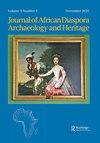殖民地新奥尔良的黑人印第安人物质记忆
Q1 Arts and Humanities
Journal of African Diaspora Archaeology and Heritage
Pub Date : 2019-05-04
DOI:10.1080/21619441.2019.1647662
引用次数: 1
摘要
近年来,新奥尔良黑人印第安人的过去受到了相当多的关注,这在一定程度上要归功于狂欢节印第安人,他们以精心制作的串珠西装而闻名,其中许多人也庆祝美国原住民的传统。尽管这一鲜活的传统充满活力,但历史学家有时对黑人与印第安人关系的时间深度或连续性持怀疑态度。殖民时期圣彼得街公墓的考古证据提供了一个机会,让我们重新考虑利用物质传统来加强城市土著和非洲裔人口之间的联系的方式,即使土著人民的人口统计存在被后来的到来所吞没。本文章由计算机程序翻译,如有差异,请以英文原文为准。
Memories of Black Indian Materialities in Colonial New Orleans
ABSTRACT The Black Indian past of New Orleans has received considerable attention in recent years, thanks in part to the Mardi Gras Indians, parading groups known for their elaborate beaded suits, many of which also celebrate Native American heritage. Despite this vibrant living tradition, historians have sometimes been skeptical of the temporal depth or continuity of Black-Indian connections. Archaeological evidence from the colonial-era St. Peter Street Cemetery provides an opportunity to reconsider the ways that material traditions were used to reinforce the connections of the city’s Native and African-descended populations, even as the demographic presence of indigenous peoples was being subsumed by later arrivals.
求助全文
通过发布文献求助,成功后即可免费获取论文全文。
去求助
来源期刊

Journal of African Diaspora Archaeology and Heritage
Arts and Humanities-History
CiteScore
0.80
自引率
0.00%
发文量
9
期刊介绍:
Journal of African Diaspora Archaeology and Heritage provides a focal point for peer-reviewed publications in interdisciplinary studies in archaeology, history, material culture, and heritage dynamics concerning African descendant populations and cultures across the globe. The Journal invites articles on broad topics, including the historical processes of culture, economics, gender, power, and racialization operating within and upon African descendant communities. We seek to engage scholarly, professional, and community perspectives on the social dynamics and historical legacies of African descendant cultures and communities worldwide. The Journal publishes research articles and essays that review developments in these interdisciplinary fields.
 求助内容:
求助内容: 应助结果提醒方式:
应助结果提醒方式:


